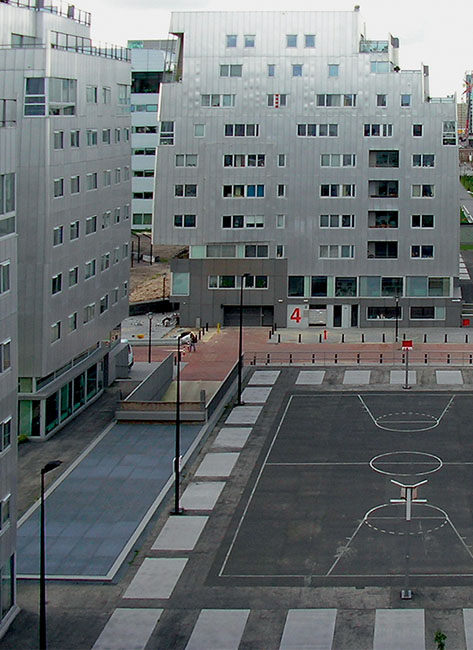De Rietlanden Amsterdam VenhoevenCS
Samenvatting
De Rietlanden in Amsterdam, een ensemble van vier woontorens en een parkeergarage naar ontwerp van VenhoevenCS, maakt deel uit van het veel grotere project Rietlanden in het Oostelijk Havengebied. Het wordt gedomineerd door infrastructuur: trein, tram, de ringweg en de Piet Heintunnel. Het woonensemble is onderdeel van een driehoekig bouwblok, dat een rand particuliere woningen langs de Oostelijke Handelskade aan de noordzijde omvat en – oorspronkelijk – treinsporen aan de zuidzijde.
Het ontwerp werd in belangrijke mate bepaald door de invloed van de zittende bewoners, krakers van de Oostelijke Handelskade. De eerste schetsen van het stedenbouwkundig ontwerp van de gemeente Amsterdam (Ton Schaap) tonen een gesloten randbebouwing aan de zuidzijde. Uiteindelijk kwam er een reeks torens, met een hoogte variërend van elf tot acht lagen, gericht op het doorlaten van licht en uitzicht voor de zittende bewoners.
Het ensemble wordt doorsneden door een weg vanaf de Oostelijke Handelskade naar de garage, die voor voetgangers en fietsers is doorgetrokken naar het openbaar vervoersknooppunt in het zuiden. Ook is er een openbaar pad in oostwest richting, langs het garagedek en onderlangs de tuinen van de bestaande huizen. Tussen dit pad en de achtertuinen is een dik rietbos aangelegd bij wijze van formele begrenzing.
Bijzonder is dat de toegangen tot de torens aan de ‘binnenkant’ liggen; de zware infrastructuur aan de zuidzijde maakt een ontsluiting aan deze kant ongewenst. Met de entrees van de torens wordt ook het openbare karakter van het dek op de parkeergarage versterkt. Dit plein, waarop een basketbalveld is aangelegd, is verbonden met de omliggende paden via luie trappen en hellingbanen. Twee torens worden ontsloten aan een openbare noordzuid doorgang; ze hebben een commerciële functie in de plint. De twee andere torens worden aan het hoger gelegen dek ontsloten. De appartementen op de begane grond liggen hier direct aan het openbare gebied, slechts gescheiden door een grote glaspui.
In de woontorens is vrijwel geen enkel appartement gelijk. In de complexe stapeling zijn woningtypen opgenomen met een dubbele hoogte, meerdere entrees en niveauverschillen in vloeren en plafonds.
De zilveren aluminium gevels en de bijzondere plastiek verschaffen de torens een vervreemdend, bijna zwevend effect; de verschillende woningen erin zijn niet herkenbaar. De oriëntatie van de torens is dubbelzinnig: de plastiek is van boven gericht op de noord(water)kant, terwijl de ‘rugzak’ aan de zuidzijde een oriëntatie naar de Piet Heinkade heeft. De materialisering van de plint is aangepast aan de wereld van het maaiveld: de stalen roosters van de torens lopen over in de bekleding van de garagewanden. Ook de detaillering van het dek is robuust en strak met roestvrij stalen relingen en betonelementen.
De parkeergarage is gemeentelijk eigendom, net als het dek en de openbare paden. De koopappartementen en verhuurbare ruimten worden beheerd door een ontwikkelaar en een Vereniging van Eigenaren. Een complexe constructie.



